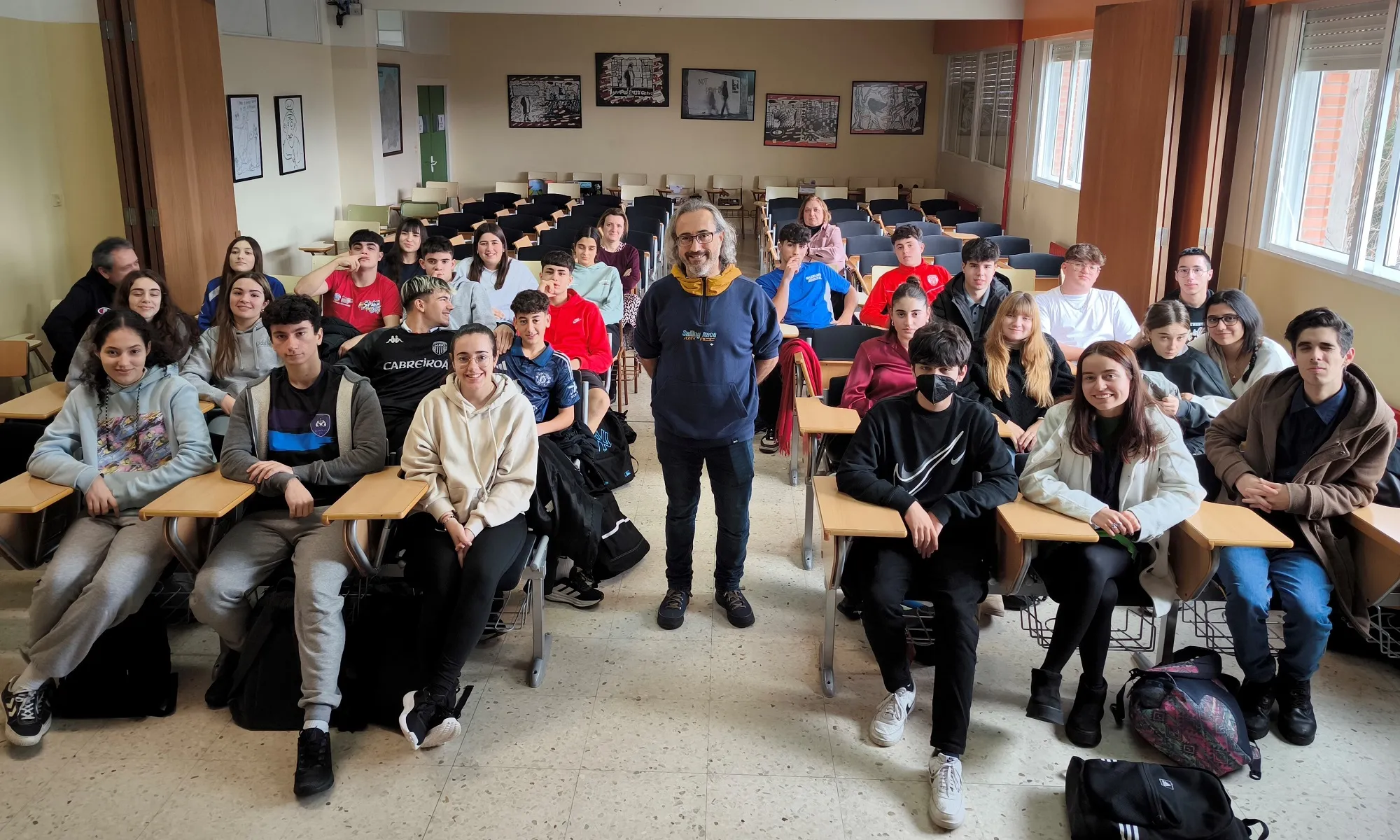


As part of our commitment to disseminating our research activity to society, every year the IGFAE offers dozens of informative talks for educational centres in Galicia, in which the different disciplines in which we do research at our centre are addressed.

Every year, our team visits more than 50 schools, giving talks and workshops to more than 1,000 students, who have the opportunity to meet the scientists working on the most cutting-edge experiments and international collaborations in Physics.
This is our list of outreach talks for the academic year 2025/2026:

Do you know how the Universe was born and how the matter that makes up stars, planets, and ourselves was formed? How do elementary particles gain mass, which is essential for the formation of atoms? Did you know that the matter we are made of has an almost identical twin, antimatter, which mysteriously vanished after the Big Bang? Particle Physics seeks answers to questions about the fundamental elements of the Universe, as well as the forces that govern them. The smaller the object we study, the bigger and more complex the instruments we need. The Large Hadron Collider (LHC), the world’s largest and most powerful particle accelerator, is a good example.

The LHC (Large Hadron Collider) is a huge 27 km ring located 100 meters underground on the border between France and Switzerland, where the CERN facilities were built. Here, beams of subatomic particles are smashed together at nearly the speed of light. Why? To study the results of these collisions and their interactions, to unravel the mysteries of matter that makes up everything in the Universe. In 2012, the LHC amazed the world with the discovery of the Higgs boson. Today, this great experiment continues to study elementary particles. Come discover how it works from the people who work there!

What are the interactions between the most fundamental building blocks of everything we know? After an introductory talk on particle physics and atomic structure, this activity proposes building nuclei, atoms, molecules, and various isotopes using coloured construction pieces that represent each type of elementary particle. This initiative is part of the unique kit “Matter piece by piece”, created in collaboration with the Por los Creativos program of the Xunta de Galicia’s Department of Education.
* Activity designed for secondary school students.

On August 12, 2026, in northern and eastern Spain, we will be able to witness a phenomenon that occurs only a few times in a lifetime: a total solar eclipse. In 2027 and 2028 we’ll also experience two partial eclipses. Beyond their fascination as natural spectacles, these events have been crucial in the history of physics: in 1919, just four years after Einstein published his theory of general relativity, an eclipse confirmed his prediction that light is bent by the gravity of massive bodies like the Sun, warping spacetime itself. Discover the science behind the most famous eclipse in history!

Cosmic rays are particles from space that constantly bombard Earth (yes, including you & me!) from all directions. Most are protons or atomic nuclei, and some are more energetic than any other particle ever observed in nature. These cosmic rays travel close to the speed of light and carry hundreds of millions of times more energy than the particles produced in the most powerful accelerator ever built, the LHC. Their origin remains a mystery, as their paths are deflected by magnetic fields in space. How are these cosmic messengers produced?

Marie Sklodowska-Curie is often cited when speaking of women’s role in physics. Yet, the Swedish Academy initially tried to deny her first Nobel Prize because she was a woman—something prevented only by her husband Pierre’s intervention. Many other figures made essential contributions to science but were hidden for years by heteropatriarchal discrimination. Alan Turing, pioneer of computing, was persecuted because of his sexuality. Lise Meitner’s essential role in the discovery of nuclear fission was downplayed compared to Otto Hahn’s recognition. In this talk, we’ll revisit these and other figures who, over centuries, helped us understand the Universe—from distant galaxies to the tiniest particles—while also paving the way toward a more diverse science.

Dark matter is one of the greatest challenges in physics today. It accounts for about 80% of the Universe’s total matter, yet the only evidence for its existence comes from its gravitational influence on cosmic scales, since it’s completely invisible across the electromagnetic spectrum. So how do we detect it? For decades, large experiments have searched for particle collisions in ultra-sensitive detectors. Satellites also seek traces of annihilation between dark matter particles and antiparticles. But so far, no direct evidence has been found. New theories suggest that particle accelerators like the LHC may provide indirect evidence. Detectors such as ATLAS and CMS are already taking first steps, and others like LHCb might be especially suited to its discovery. Could particle physics have the final word on dark matter?

The Chernobyl nuclear accident in 1986 caused nearly a hundred immediate deaths (and thousands more later) along with severe biological impacts. Vast amounts of radioactive materials were released—equal to the energy of 500 nuclear bombs like Hiroshima. But nuclear energy also has a positive side. In this talk, we’ll explore whether “radiation” and “radioactivity” mean the same thing. Beyond large-scale energy production, nuclear technology enables medical imaging, diagnostics, and safer, more effective treatments for diseases like cancer.

Control of information shapes every aspect of daily life. After the digital revolution of the 20th century, the 21st century is witnessing the quantum revolution. This paradigm shift poses enormous scientific, intellectual, and geopolitical challenges for today’s youth. A new world is opening before us, and Galicia is investing in joining it. That’s why it’s important to understand the basics: what a qubit is, how quantum computers work, how quantum information is measured and manipulated, where we are now, who the main players are, what the impact will be on our lives, and why we should pay attention to this revolution in progress.

In its beginnings, astronomy was much like what we can do on a starry night: observing the light from cosmic objects. But in the last century, science has opened new windows. In the early 20th century, cosmic rays were discovered as another messenger. In the 21st century, the detection of cosmic neutrinos by IceCube (2012) and gravitational waves by LIGO (2015) marked a giant leap—astronomy beyond light. Combining four messengers—light, cosmic rays, neutrinos, and gravitational waves—has given rise to a new field of physics whose potential is only starting to unfold.

The early 20th century marked great advances in nuclear physics and the understanding of radioactivity. Less than 50 years passed between the accidental discovery of radiation and the creation of the atomic bomb in the Manhattan Project. In that time, huge progress was made in understanding the atomic nucleus, leading ultimately to the creation of CERN, the world’s largest international laboratory, where IGFAE participates.

Neutrinos are a fundamental part of the Universe. Along with electrons, protons, and neutrons, they make up the matter we know. But unlike the others, neutrinos are very “tricky” and extremely difficult to detect. That’s why we build giant detectors or place them in ultra-quiet environments. Experiments such as NEXT, DUNE, and Hyper-Kamiokande—in which IGFAE participates—are examples. Neutrinos keep surprising us and provide clues to some of the strangest puzzles in the Standard Model. Key questions remain: Is the neutrino its own antiparticle? How do they propagate? How many types exist? The answers may come from the next generation of scientists.

For decades, discovering new particles and testing physics models has depended on accelerators and colliders. But reaching higher energies requires ever-larger machines, limited by material constraints. Alternatives exist: some labs now produce laser pulses with powers up to 1 petawatt (10¹⁵ watts)—about 9,000 times Spain’s total electricity grid! When these lasers strike matter, the material ionizes into plasma. The laser’s extreme electric fields can then accelerate particles within the plasma, achieving high energies in much more compact accelerators, with applications in medicine and engineering. IGFAE has some of these devices, and this talk explains how we use them.

Proposed by Einstein in 1915 and detected a century later, gravitational waves are a new way to explore the Universe. Thanks to ultra-sensitive detectors like LIGO, we can “listen” to spectacular cosmic collisions—black holes and neutron stars merging billions of light-years away. Their extreme gravity ripples spacetime itself. What have we learned from gravitational waves, and what might future space-based detectors reveal?

Black holes, predicted by Einstein, are among the most mysterious objects in the Universe. Initially considered mere mathematical curiosities, evidence gathered in the 20th and 21st centuries show they are common: from stars orbiting our galaxy’s center, to gravitational wave detections, to the first direct image by the Event Horizon Telescope. Despite their mystery, some of the principles behind black holes can be explained with simple drawings, illustrating Einstein’s idea that nothing travels faster than light. Let’s draw a hypothetical fall into one of these monsters!

We have known for nearly a century that our Universe was born in a colossal explosion: the Big Bang. But what happened next? Everything we see today, from the street outside to the most distant galaxies, came from the events immediately following that explosion. In an unimaginably brief instant—shorter than the blink of an eye—space filled with a mysterious material. Revealing its properties may help us uncover the secrets of the Universe’s birth.

Sometimes, to understand the tiniest things, we need to look at stars—how they are born and how they die. The tools we invent in laboratories to study atomic nuclei also serve to diagnose and treat diseases. This talk takes you on a fascinating journey through the subatomic world, showing how and why our very essence is made of stardust.

Even something as simple as the darkness of night reveals clues: the Universe was once smaller and hotter, it hasn’t always existed, and it had an origin. In that darkness, though invisible to our eyes, there is a light more abundant than that of all stars and galaxies combined. But how can we detect it? What can we deduce from it? And what does it tell us about the past, present, and future of the Universe?

Stars are born and evolve for millions of years, but all must die. Their end depends on their mass. The most massive stars collapse into black holes, where gravity is so strong that not even light escapes. Smaller stars, like our Sun, become white dwarfs—dense, cold remnants that have burned out their fuel. Others end in violent supernova explosions, leaving behind neutron stars so dense that a sugar cube of their matter would weigh over 100 million tons on Earth. Let’s explore these incredible stellar remnants, a major focus of scientific research worldwide.